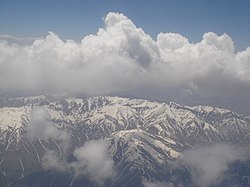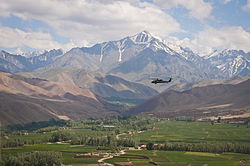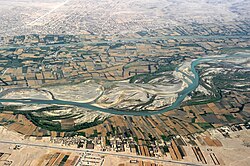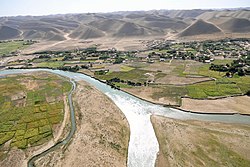Geography of Afghanistan
|
| ||
| Continent | Asia | |
| Subregion | Central Asia | |
| Geographic coordinates | 33°00′N 65°00′E / 33.000°N 65.000°E | |
| Area - Total - Water |
Ranked 41st 647,500 km² 0 km² (landlocked) | |
| Coastline | 0 km (0 mi) | |
| Land boundaries | 5,529 km (3436 mi) | |
| Countries bordered | Pakistan 2,430 km, Tajikistan 1,206 km, Iran 936 km, Turkmenistan 744 km, Uzbekistan 137 km, China 76 km | |
| Highest point | Nowshak, 7,486 m / 24,560 ft | |
| Lowest point | Amu Darya near Khamyab District, 258 m / 846 ft | |
Afghanistan is in the middle of Asia. The country is landlocked and mountainous, and has most of the Hindu Kush mountains. There are four major rivers in the country: the Amu Darya, the Hari River, the Kabul River and the Helmand River. The country also contains a number of smaller rivers, lakes, and streams.
Borders
Afghanistan has 5529 km of borders. They are with neighbouring countries:
- Pakistan: 2,430 km, known as the Durand Line. This is in the south and southeast of Afghanistan.
- Iran, to the west of Afghanistan. The border is 936 km long
- Tajikistan has a border of 1,206 km with Afghanistan to the north
- Turkmenistan has a border of 744 km
- Uzbekistan has a border of 137 km
- Afghanistan also has a disputed border with China. It is 76 km in length and is in the far northeast of the country. This is disputed by Pakistan and Tajikistan which both claim the area.
The borders are called "porous". That means that in many places people can cross over with not much official control.
Land
Afghanistan has a lot of rugged mountains known as the Hindu Kush as well areas of desert.
- Natural hazards
- Damaging earthquakes occur in the Hindsh mountains; flooding and droughts in the south and south-west of the country.
- Natural resources
Afghanistan's natural resources include: natural gas, petroleum, coal, copper, uranium, gold, silver, chromite, talc, barites, sulfur, lead, zinc, iron ore, salt, precious and semiprecious stones.[1][2][3][4][5][6]
Mountain systems
The Hindu Kush reaches a height of 7485 m. / 24,557 ft. at Nowshak, Afghanistan's highest peak. Of the ranges extending southwestward from the Hindu Kush, the Koh-i-Baba reaches the greatest height (Shah Fuladi, 5,142 m /16,870 ft). The Safed Koh range, which includes the Tora Bora area, dominates the border area southeast of Kabul.
The area towards the Khyber Pass across the Safed Koh are in eastern Afghanistan; at the top the height is 1070 m. / 3,509 ft. at Landi Kotal. This area is near to Pakistan, the town of Torkham is five kilometres from Pakistan.
Geography Of Afghanistan Media
Snow-covered Koh-i-Baba mountains in Bamyan Province
Snow-covered Hindu Kush mountains in Afghanistan
Snow-covered mountains in Paktia Province
The Wakhan District of Badakhshan Province, which connects Afghanistan with neighboring Tajikistan in the north, China in the east and Pakistan in the south.
Helmand River and Boghra Canal running parallel in Helmand Province
Takhar Province in northern Afghanistan
The Kokcha River in Badakhshan Province
References
- ↑ Afghanistan, CIA World Factbook. Archived 2016-07-09 at the Wayback Machine
- ↑ Gold and copper discovered in Afghanistan
- ↑ Uranium Mining Issues: 2005 Review
- ↑ 16 detained for smuggling chromites Archived 2008-02-13 at the Wayback Machine, Pajhwok Afghan News.
- ↑ Afghanistan’s Energy Future and its Potential Implications, Eurasianet.org.
- ↑ Govt plans to lease out Ainak copper mine, Pajhwok Afghan News. Archived 2008-02-22 at the Wayback Machine
Other websites
- Topographic map of Afghanistan (1 : 300 000) www.cesty.in
- Persia (Iran), Afghanistan and Baluchistan is an old map, featuring Afghanistan, from 1897. It's written in English.
- Afghanistan, Beloochistan, etc. is another old map, from 1893. It was published by the Methodist church.











